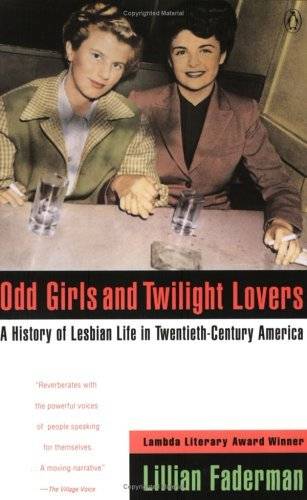Odd Girls And Twilight Lovers
Lillian Faderman

Faderman charts the evolution of the concept of the ‘lesbian’ as a 20th-century social construct and shows how love between women, once known at the turn of the century by such terms as ‘romantic friendship’ or ‘sentimental friendship,’ came to be called ‘lesbianism.’ What was once not a realistic alternative to marriage became possible as women became educated, demanded equal rights, and came out of the home and into the workforce. With increased opportunities for independence, women no longer needed men’s financial support to survive and, as a result, love between women was no longer perceived as innocently as it had been in the past. This is a much-needed book and is highly recommended for all public libraries both for its information about the perception and treatment of this particular minority group in America, as well as for its historical and sociological contribution. Its scholarly approach and content also make it a necessity for women’s studies collections.
– Patricia Sarles, Mt. Sinai Medical Ctr., New York
Copyright 1991 Reed Business Information, Inc. –This text refers to the Hardcover edition.
From 500 Great Books by Women; review by Erica Bauermeister
For those readers unfamiliar with Stonewall, Lesbian Nation, Daughters of Bilitis, lipsticks, or the difference between ‘romantic friendships’ and lesbian-feminists, or for those readers who want to learn more, Odd Girls and Twilight Lovers provides an accessible, wide-ranging, meticulously researched history. Using information drawn from varied sources including literature, sociological and psychological studies, newspaper articles, military pamphlets, and movies, Lillian Faderman sets out to show the metamorphosis of a movement. At times the generalizations that occur as a result work against her stated acknowledgment of the diversity among individual lesbians, yet these generalizations also serve to show the broader sweeps and clashes in what has been a rapidly changing and often tumultuous history. Beginning with nineteenth-century romantic friendships and the first all-women’s colleges, progressing through the sexologists of the 1920s and the openness of the war years, on to the McCarthy era, the radical 1960s and 70s, and the more diversified 1980s and 90s, Lillian Faderman documents ‘the extent to which sexuality, and especially sexual categories, can be dependent upon a broad range of factors that are extraneous to ‘sexual drive.’ ‘ Perhaps the most revolutionary and exciting thing about this history, beyond the very fact of its existence, is its ability to present lesbianism not only as a sexual orientation, but as a movement that has been both affected and defined by a constantly shifting economic, political, and cultural climate.
Check for it on:
Details
| ISBN | 140171223 |
| Genre | Award Winner; History |
| Copyright Date | 1991 |
| Publication Date | 01-Jun-92 |
| Publisher | Penguin Paperbacks |
| Format | Trade Paperback |
| No. of Pages | 400 |
| Language | English |
| Rating | Great |
| BookID | 9095 |

